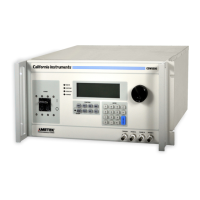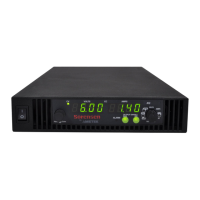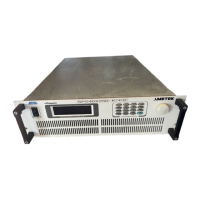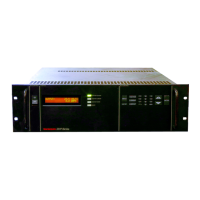User Manual California Instruments
30 CSW Series
3.4.3 Single-Phase Input Connections
The CSW system is designed for three-phase input power operation, either 3-wire (USA) or 4-wire
(EUR) plus a chassis safety ground. However, if only single-phase input power is available, the
configurations listed in paragraph 2.1.1 are possible.
3.5 Output Power Connections – TB2
The output terminal block, TB2, is located at the rear of the unit. Refer to Figure 3-3 for an illustration of
the power source rear panel and all terminal strips and connectors. The external sense inputs allow the
power system output voltages to be monitored directly at the load and must be connected either at TB2
or the load when the sense is programmed for external. The external sense input does not have to be
connected when Internal Sense is programmed. The external sense wires are to be connected to TB3
on the rear panel and should be run as a twisted pair for short lengths. Sense leads over three (3) feet
long should be run as a twisted shielded pair. Refer to Figure 3-4 for all connections. Included in the
power source ship-kit is a safety cover. This cover is used to cover the AC Line input, TB1, the Power
Output terminal block, TB2, and the External Sense terminal block, TB3. Strain reliefs are included with
the safety cover.
Note: The output of the power source is isolated from the input line and floating from
chassis ground. The Output Neutral must not float more than 20 volts or an error
will be reported and the output will shut down.
3.5.1 Wire Gauge Selection
The following guidelines assist in determining the optimum cable specification for
your power applications. These guidelines are equally applicable to both DC and low frequency AC (up
to 450 Hz) power cabling. The same engineering rules apply whether going into or out of an electrical
device. Thus, this guide applies equally to the input cable and output cable for this California Instrument
power source and application loads.
Power cables must be able to safely carry maximum load current without overheating or causing
insulation destruction. It is important to everyday performance to minimize IR (voltage drop) loss within
the cable. These losses have a direct effect on the quality of power delivered to and from instruments
and corresponding loads.
When specifying wire gauge, the operating temperature needs to be considered. Wire gauge current
capability and insulation performance drops with the increased temperature developed within a cable
bundle and with increased environmental temperature. Thus, short cables with generously derated
gauge and insulation properties are recommended for power source applications.
Avoid using published commercial utility wiring codes. These codes are designed for the internal wiring
of homes and buildings and accommodate the safety factors of wiring loss, heat, breakdown insulation,
aging, etc. However, these codes consider that up to 5% voltage drop is acceptable.
Such a loss directly detracts from the quality performance specifications of this power source.
Frequently, these codes do not consider bundles of wire within a cable arrangement.
In high performance applications, as in motor start-up and associated inrush/ transient currents,
additional consideration is required. The cable wire gauge must consider peak voltages and currents,
which may be up to ten times the average values. An underrated wire gauge adds losses, which alter
the inrush characteristics of the application and thus the expected performance. The following table
identifies popular ratings for DC and AC power source cable wire gauges.

